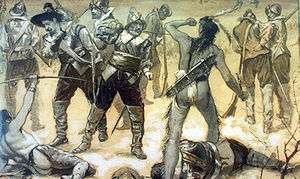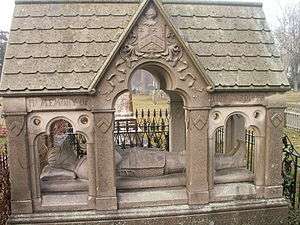Lion Gardiner
| Lion Gardiner in East Hampton | |
|---|---|
|
The tomb of Lion Gardiner in East Hampton, New York was built in 1886 and designed by James Renwick, Jr. depicts him in recumbent effigy pose (Photo, April 2006). | |
| Background information |

Lion Gardiner (1599–1663), an early English settler and soldier in the New World, founded the first English settlement in what became the state of New York on Long Island. His legacy includes Gardiners Island, which is held by his descendants.
Biography
Early life
Lion Gardiner was born in England in 1599[1] and died in East Hampton, New York, in 1663.[1] He and his wife Mary left Woerden, the Netherlands, and embarked, probably at Rotterdam, the Netherlands, in the ship Batcheler. It was bound for New England by way of London and departed on July 10, 1635. The ship arrived at Boston at the end of November in 1635.
Governor John Winthrop, the elder, noted Gardiner's arrival in his Journal under the date November 28: "Here arrived a small Norsey bark of twenty-five tons sent by Lords Say, etc, with one Gardiner, an expert engineer or work base, and provisions of all sorts, to begin a fort at the mouth of the Connecticut. She came through many great tempests; yet, through the Lord's great providence, her passengers, twelve men, two women, and all goods, all safe."[2][3][4]
Marriage and family
Shortly before departing from the Netherlands, he married Mary Willemsen Deurcant, the daughter of Dericke Willemsen Deurcant and Hachin Bastiens, who was born at Woerden about 1601. She died in 1665 in East Hampton, New York. She was buried next to her husband.[5] They were the parents of three children: David, Mary and Elizabeth.
Their only son, David Gardiner, was born on April 29, 1636 at Saybrook.[1][6] He married on June 4, 1657, Mary Leringman, a widow, at St. Margaret's Parish in the City of Westminster, England.
Mary Gardiner[7][8] was born on August 30, 1638 at Saybrook, Connecticut. She married in 1658, Jeremiah Conkling, the son of Ananias Conkling, who was from Nottinghamshire, England.
Elizabeth Gardiner,[9] was born on September 14, 1641 at the Isle of Wight, New York. She married in 1657, Arthur Howell, a son of Edward Howell of Southampton, England. Her death led to the witchcraft trial of Elizabeth Garlick.[10][11]
Career
A military engineer in service of the Prince of Orange in the Netherlands along with John Mason, he was hired by the Connecticut Company in 1635 to oversee construction of fortifications in the new colony. He finished and commanded the Saybrook Fort at the mouth of the Connecticut River during the Pequot War of 1636–1637.[12] In 1639 he purchased from the Montaukett tribe an island which they called Manchonat, located between the North Fork, Suffolk County, New York and South Fork, Suffolk County, New York. The original grant by which Gardiner acquired proprietary rights in the island made it an entirely separate and independent "plantation," in no way connected either with New England or New York. He was thus empowered to draft laws for Church and state. He called it the Isle of Wight. It has since become known as Gardiners Island.
In 1660 he wrote a firsthand account, Relation of the Pequot Warres. The manuscript was lost among various state archives until rediscovered in 1809; it was first published in 1833.[13]
Death
Lion Gardiner was buried in East Hampton, New York. In 1886 a recumbent effigy was erected to his memory,[14] and his supposed grave was opened. In it, a skeleton was found intact. It was that of a man over six feet in height, with a broad forehead and strong jaws. Gardiner (and many of his progeny) are buried in the South End Cemetery by Town Pond.[15]
Descendants
Lion Gardiner's descendants number in the thousands today. Some of his notable descendants include:
- David Gardiner, New York State Senator, father of Julia Gardiner Tyler[16][17]
- Julia Gardiner Tyler,[16][18] daughter of David Gardiner; second wife of President John Tyler; First Lady of the United States from June 26, 1844, to March 4, 1845
- Gardiner Greene Hubbard,[19] lawyer, financier, and philanthropist. He was one of the founders of the Bell Telephone Company and the first president of the National Geographic Society.
- Aaron Bancroft,[20] clergyman, husband of Lucretia Chandler, daughter of John Chandler
- Eliza Bancroft,[20] married to John Davis, lawyer, businessman and governor of Massachusetts
- George Bancroft,[20] historian and statesman
- Chevalier Benjamin C. Bradlee, Vice President-at-Large of the Washington Post, Fmr. Executive Editor of the Washington Post during Watergate
- Quinn Bradlee, Author, Founder and CEO of FriendsOfQuinn.com
- Alfred Conkling, U.S. Representative, judge of the District Court for the Northern District of New York, U.S. Minister to Mexico
- Roscoe Conkling, U.S. Senator, Republican political boss from New York
- Alfred Conkling Coxe, Sr., judge of the District Court for the Northern District of New York and later the Court of Appeals for the Second Circuit, author
- Alfred Conkling Coxe, Jr., judge of the District Court for the Southern District of New York
- Louis O. Coxe, poet, playwright, and professor from Maine best known for the Broadway version of Billy Budd
- Bancroft Davis married Frederika Gore King, the daughter of U.S. Representative James Gore King
- Horace Davis, a United States Representative from California
- Henry Cabot Lodge, Jr., Republican United States Senator from Massachusetts; U.S. Ambassador to the United Nations, Ambassador to South Vietnam, Ambassador to West Germany; Special Envoy to the Holy See; 1960 Republican nominee for Vice President
- George C. Lodge, the Jaime and Josefina Chua Tiampo Professor of Business Administration Emeritus at Harvard Business School
- John Davis Lodge, actor, Republican politician; U.S. Representative; governor of Connecticut; ambassador to Spain, Argentina, and Switzerland
- John Gardiner Calkins Brainard, lawyer, editor and poet.
- Gilbert Hovey Grosvenor, first full-time editor and president of the National Geographic Society.
- Gilbert Melville Grosvenor, is past president and chief executive of the National Geographic Society, as well as a former editor of National Geographic Magazine.
- Melville Bell Grosvenor, was the president of the National Geographic Society and editor of National Geographic Magazine from 1957 to 1969.
- Mabel Gardiner Hubbard[21] married Alexander Graham Bell, an eminent scientist, inventor, engineer and innovator who is credited with inventing the first practical telephone.
- Winthrop Gardiner, Jr.,[22] the 14th Proprietor of Gardiners Island. He married Norwegian figure skater and actress, Sonja Henie, after his divorce from actress Mildred Shay.
- Gertrude Van Cortlandt Wells, married Schuyler Hamilton, Jr., the son of Schuyler Hamilton and great-grandson of Alexander Hamilton
- Selah Brewster Strong,[23][24] lawyer and politician from New York
- Marcius D. Raymond,[25] publisher, writer, genealogist, editor, historian
- David Thomson, 3rd Baron Thomson of Fleet, Canadian billionaire and art collector
- Kenneth Thomson, 2nd Baron Thomson of Fleet, Canadian billionaire, art collector, and philanthropist
- Roy Thomson, 1st Baron Thomson of Fleet, Canadian businessman
- David Gardiner Tyler, Democratic lawyer and politician, Virginia State Senator, U.S. Representative, son of president John Tyler
- Lyon Gardiner Tyler,[26] educator and historian, another son of president John Tyler
- Robert David Lion Gardiner, Columbia College (1934), once an owner of Gardiners Island "...the 16th Lord of the Manor...".[27]
- Alexandra Creel Goelet, current owner of Gardiners Island. The Goelets offered to place a conservation easement on the island in exchange for a promise from the town of East Hampton not to up-zone the land, change its assessment, or attempt to acquire it by condemnation. The Goelets and East Hampton agreed upon the easement through 2025.[28][29]
Notes
- 1 2 3 Gardiner, 84
- ↑ Dunn, 207
- ↑ Dunn, 161
- ↑ Dunn, 783
- ↑ Mary Willemsen Deurcant Gardiner at Find A Grave
- ↑ Gardiner, 86
- ↑ Gardiner, 93
- ↑ Mary Gardiner Conkling at Find A Grave
- ↑ Gardiner, 94
- ↑ Steven Gaines (June 1, 1998). Philistines at the Hedgerow: Passion and Property in the Hamptons (hardcover). Little Brown & Co. pp. 80–84. ISBN 9780316309417.
Lion Gardiner would have none of this.
- ↑ John Hanc (October 25, 2012). "Before Salem, There Was the Not-So-Wicked Witch of the Hamptons". Smithsonian Magazine. Retrieved August 15, 2015.
Elizabeth Garlick, a local resident who often quarreled with neighbors.
- ↑ Gardiner, 6
- ↑ Lion Gardiner, Relation of the Pequot Warres, 1660 Ed., W. N. Chattin Carlton, Libraries at University of Nebraska-Lincoln, Electronic Texts in American Studies University of Nebraska - Lincoln Year 2007
- ↑ Gardiner, 74
- ↑ Lion Gardiner at Find A Grave
- 1 2 Gardiner, 145
- ↑ Senator David Gardiner at Find A Grave
- ↑ Julia Gardiner Tyler at Find A Grave
- ↑ "Gardiner Greene Hubbard Biography", National Geographic
- 1 2 3 Gardiner, 112
- ↑ "Mrs. A.G. Bell Dies. Inspired Telephone. Deaf Girl's Romance With Distinguished Inventor Was Due to Her Affliction.". New York Times. January 4, 1923.
Mrs. Mabel Hubbard Bell, widow of Alexander Graham Bell ... Mrs. Bell was born in Cambridge, Massachusetts, November 25, 1859 [sic], the daughter of Gardiner Green Hubbard [sic] ...
- ↑ Obituary: "Winthrop Gardiner, Jr." New York Times. October 18, 1980.
- ↑ Selah B. Strong at Find A Grave
- ↑ History of the city of New York: its origin, rise and progress, Volume 3 By Martha Joanna Lamb, New York: THE A. S. BARNES COMPANY. 1877
- ↑ Gardiner, 124
- ↑ Sherwood Forest Plantation - Home of president John Tyler at www.sherwoodforest.org
- ↑ "Robert D.L. Gardiner, 93, Lord of His Own Island, Dies". New York Times. August 24, 2004. Retrieved 2014-01-29.
Robert David Lion Gardiner, the last heir to bear the name of the family that has owned Gardiner's Island, off the coast of Long Island, for nearly four centuries, died yesterday at his home in East Hampton, N.Y. He was 93. ...Mr. Gardiner called himself the 16th Lord of the Manor and saw himself as a custodian of his family's history on what is said to be the largest privately owned island in the world.
- ↑ Newsday, May 24, 2005
- ↑ "Debating the Future Of Gardiners Island", New York Times, September 5, 2004
References
- Dunn, Richard The journal of John Winthrop, 1630-1649.Abridged Edition: published by Harvard University Press
- Gardiner, Curtiss C. Lion Gardiner, and his descendants with Illustrations 1599-1890. St. Louis, Missouri : A.Whipple, Publisher
Further reading
- Lion Gardiner, and his descendants with Illustrations 1599-1890. by Curtiss C. Gardiner, St. Louis, Missouri : A.Whipple, Publisher 1890
- Gardiners Island Lighthouse
- Encyclopedia of New York: Gardiners Island
- The Worlds of Lion Gardiner Stony Brook University, March 20–21, 2009
External links
- Relation of the Pequot Warres (1660)
- The journal of John Winthrop, 1630-1649 Abridged Edition: by Richard Dunn, published by Harvard University Press
